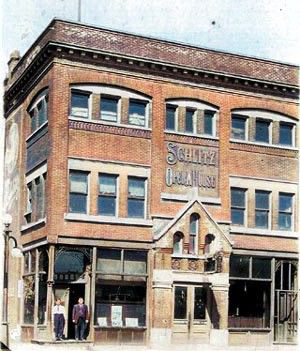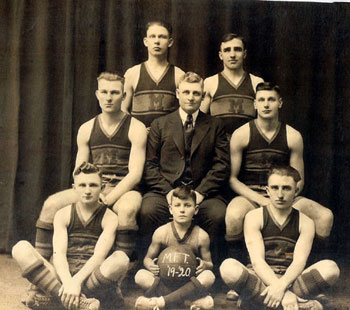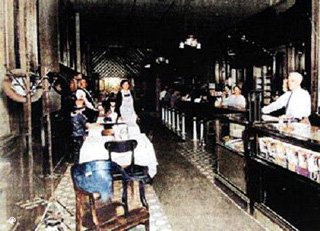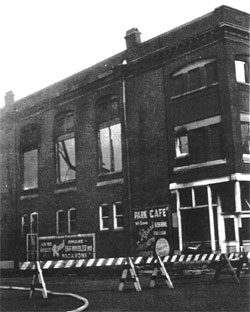Minonk's past
|
|
|
A look at Minonk's past |
|
Let us go back in time to a Minonk none of us remembers. One can find some very interesting articles in the Minonk newspapers concerning the early days. In the January 25, 1912, newspaper of 65 years prior, it stated that Harrison Miller of Ava, Missouri, had not been to Minonk since before the Civil War. He then lived on a farm west of Rutland and in 1858 walked to Minonk to see the Prince of Wales, later King Edward VIII of England, who came to Minonk to hunt prairie chickens. Miller said that the whole country was open prairie and that he killed many deer and wolves. During that time, there were only a few houses in Minonk and the Illinois Central Railroad had nothing but a platform for the Minonk station. |
If one was to choose a part of Minonk's history to be remembered, it might be one of the most interesting buildings. It was built in 1896 and was located on 601-603 Chestnut Street on the old Young's Chevrolet Garage corner. This wonderful building was called the Schlitz Opera House. It was a three-story building with a basement, two rooms on the second floor, and a top floor, which was the hall or opera house. The Schlitz Brewing Company of Milwaukee, Wisconsin, owned the building, which cost $34,000 to erect and was 40 by 100 feet. The grand opening was February 26, 1897, with people viewing from early morning until closing time. The saloon, located in the south room on the ground floor, was 20 by 100 feet divided into three compartments. The entrance was on the corner and inside to the right was a cigar stand, made of oak and carved work, and a wine case finished with oak and French plate glass. |
|
Page 2
Next came the swinging doors, each having an oval French plate glass with the name "Schlitz" on the face. The windows at the side of the doors were made of art glass. Entering the main room, the bar was to the right. The back bar was 24-feet long and 11-feet high with three large French plate mirrors. It was of oak finish and beautifully carved. The front bar was 24-feet long made of oak with a mahogany top, a slate base, and a brass railing that ran the entire length. There were four handsomely designed tables and eleven chandeliers with three lights apiece, which were lit by incandescent electric lights. The front chandeliers had five lights. The north room at that time was unoccupied. In 1908, Juliza and Emmyline Wagester operated a millinery shop in this room. Other businesses at this location were a picture show, a pool hall, and a feed store. The two bowling lanes in St. Patrick's Church basement were dismantled and moved to this north room. The proprietor of the bowing alley was George Doblesky; Eddie Gerdes and Clifford Blackmore were pinsetters. |

|
|
Page 3
The stairway going up to the opera house above was of hard maple. The auditorium was 40 feet by 60 feet, the stage was 20 by 40 feet, and the balcony was 20 by 40 feet. The room contained 65 electric lights and 100 opera chairs. To the left of the stairs were a checkroom and a ladies' toilet room with marble washbasins and two closets. The Streator Decorating Company put in $700 worth of scenery depicting a parlor, chamber, kitchen, forest landscape, street, and garden. The stage was illuminated by 30-lights and the drop curtain had a beautiful scene of Naples, Italy. Following is a representation of the many events held in the opera house including balls, moving picture shows, professional stage acts, bazaars, plays, patriotic meetings, and commencements. |
The first events to be held in 1897 were a firemen's ball, a dramatic entertainment by the schools of Misses Foote and Gallagher, the 1897 high school commencement with six young ladies and one young man, and the GAR (Grand Army of the Republic, a Civil War veterans' organization), with a lecture by the Rev. Joe Bell of Streator. Also that year the Minonk Ball Club held a dance with music by the Lowe's Orchestra of Bloomington. The orchestra performed in concert an hour before the dance, which lasted from 9 p.m. until 2:30 p.m. In July of 1899, the opera house held the Graphophone and kinetoscope moving pictures of an entire act of the beautiful opera Martha, with all the music sung in the original production. This show was under the management of the Stevens Entertainment Company of Kentucky, Chicago, and Denver. Admission was 10¢, 20¢, and 30¢. Later that year, the manager of the opera house, Mr. Kane, stated that, "things theatrical are but poorly patronized here." He had to "go out and make a personal canvas and a strong plea to get together a house of any kind, no matter how good the attraction." |
|
Page 4
The old Roller Mill, which was located on west Fourth Street in Minonk, burned down in 1910. Many people were at a masquerade ball at the Schlitz Opera House that night and would look out the window periodically and someone would say, "Is anything doing yet?" and the answer was, "No, not yet." When they saw flames, many went to watch the mill burn. In January 1912, the Cosmopolitan Orchestra engaged Dr. W. S. Filly, his dog, Dunk, and a motion picture show. Filly had one of the best motion picture machines and his educated dog was a part of the picture show performance. In the Rock of Ages fire scene, the dog operated the fire apparatus to turn the water on and then exited the burning building. There was a dance after the show. Tickets cost 75¢, but entertainment was only 50¢. |
Another event that year was a grand musicale performed by the Minonk Citizens' Band and Cosmopolitan Orchestra. There was a vocal solo by Miss Watson; a violin solo by Max Smith; a cornet solo by Henry Beyer; a piano solo by Ella Weedman; a male quartet by Messrs. Stimpert, Stoneman, Hilsabeck, and Schroeder; a baritone vocal solo by Martin O'Rourke; and a trombone solo by B. C. Schroeder. Then on September 17, 1912, there was a Thom Thumb Wedding with 83 "little folks" from Minonk churches. The program was planned by the women of the Christian Church. The Morris Stock Company appeared one week in May 1913 with a different play each night. A few of the performances were Mr. Kearny from Killarny, Wedded and Parted, and A Flight for Honor. The Minonk High School class day and graduation were held at the Schlitz Opera House that year. Snedden's Orchestra played for the graduation exercise. |
|
Page 5
Minonk's Opera Club engaged the Callahan Dramatic Company with Miss Marion Sherwood and a fine cast. One of the plays was The Spendthrift, dealing with "the present important problem of the High Cost of Living." It was advertised as the best play ever rendered in Minonk. One year this acting group brought its own waterproof square-end canvas tent theatre and set up in the vacant lot north of the Schlitz building. The group included 30 people, a 15-piece band, and a 9-piece orchestra. This lot was also used for softball games. The Minonk Fans basketball team, a semi-professional team, and the Minonk High School basketball teams played in the opera house. The high school did not have a gymnasium until May 1935 and the top floor of the old East Side School was not conducive to basketball playing, so the school rented the opera house for its functions. The Minonk Fans team, formerly known as the Illinois Club team, was organized in 1917. Some of the team members listed over the years were: Howard Jury, Fred Meierhofer, John Manley, Gary Phillips, Bill Whitler, Pete Elliott, Louis von Behren, and Francis Halfman. |

The early 1920s found six Fans team players who made up one of the winningest teams in the area. These six shown above were: First row left: Richard "Dickie" Devon, Mascot Raymond Ketchmark "Little Sip", George "Dutch" Halfman; Second row left: Joseph "Sip" Wolf, Manager R. R. Sutton, John "Jake" Meierhofer; Third row left: Floyd "Bucky" Jones, Herman "Smiley" Halfman. Folkert Vissering was secretary-treasurer. |
|
Page 6
In 1919, the team was reorganized and became "The Minonk Fans Team." The new jerseys were blue with gold stripes and a letter M in gold on the front. Khaki-colored pants and blue stockings with gold stripes completed the uniform. The Schlitz was again rented and remodeled. The goals were solidly built, the south windows were covered with latticework, and grandstand seats were erected on the stage. The big swinging doors leading to the entrance of the hall were closed for games and a new door was put in at the entrance. The Minonk Fans team was hard to beat and over the years played teams from Fairbury, Magnolia, Princeville, La Salle, and Peoria. It was reported that the Fans defeated such teams as the New York Nationals, the South Wilmington Seals, the Freeport Badgers, the La Porte, Indiana YMCA, the Chicago Legion, and local teams. It seemed as if every basketball team in the country wanted to play in Minonk. The team daily received letters not only from Illinois, but also from many other states. They all wanted "to knock off the Minonk Fans." |
In the December 16, 1920, Minonk News-Dispatch, the paper stated that the Thomas Cats of Rockford were looking forward to playing the Minonk Fans. This team, all former high school stars and several college celebrities, beat every team in its territory and were looking forward to more teams to conquer. The Minonk team was more than ready to play and won 36-19 in the presence of nearly 400 fans packed into every available space at the Schlitz, including the stage, gallery, four corners, and onto the playing floor. The fans were so excited that Cloyd Phillips forgot about his girlfriend and went to sit with a group of friends. Postmaster W. H. "Tonica" Ryan unknowingly hit Charlie Ridge on the arm. Charlie did not pay too much attention until the following morning when he noticed his arm was black and blue. Manager Sutton was sitting on the front of a chair on which his wife was standing and when Rockford was given a free throw she grabbed her husband's hair with both hands and pulled with all her might. She did not realize it and he took it like a good sport. |
|
Page 7
The Minonk Fans team played in the winter months continually until December 1925 when it was decided not to have a team that year except for a holiday tournament. This decision was made because of the loss of some star players and lack of practice time. Scores were again found in the 1929 newspaper with mostly all new players. After World War I, there was a military ball at the Schlitz. It was one of the biggest events of its kind to take place in Minonk. The hall was jammed with dancers and spectators. Many boys were in uniform and privates, corporals, sergeants, lieutenants, captains, and majors were there. Music was by Goforth's Orchestra of Bloomington. Mayor Simater was called out of town, so Corporal Wilford Ward filled in and led the grand march. Dancing went on until almost 3 a.m. The ball was given by the Minonk branch of the American Legion. |
Also in 1920, the Minonk Volunteer Fire Department held its 26th Annual Ball at the Schlitz. The firemen wore their new uniforms of blue with shiny brass buttons and matching caps. The grand march was led by Fire Marshall W. H. Ryan and Assistant Chief R. R. Sutton and their wives. An added attraction was a home talent play, a three-act farce entitled, A Doctor By Courtesy. Seelig's eight-piece orchestra gave a concert and provided music for dancing. In the September 14, 1922 Minonk News-Dispatch, the Minonk Fans team decided that, "If no other hall was available than the Schlitz, that no time should be lost in securing it and making improvements, including a shower bath." Improvements were made and the hall was reported to be in excellent shape. The floor was said to be one of the best, aside from big gymnasium floors. Two balconies were completed and the stairway remodeled. The hall could easily accommodate 700 people. |
|
Page 7
In 1925, Edward "Dude" Ryan bought the Schlitz Opera House from the Schlitz Brewing Company and again the hall was rented to the high school for basketball purposes, two nights a week, and for roller skating four nights a week. Ryan tore many coats of wallpaper from the walls of the south room, patched the plaster, and repaired the brickwork. He then opened a restaurant, with tables along the south wall and a counter on the north. The kitchen was located to the west. Many Minonk citizens remember this building and restaurant. A few of the waitresses who worked for Dude Ryan and his wife Molly over the years were: Louise Smith, Annie Flohr De Freese, Marie Flohr Wehking, and Clara O'Brien Stimpert. Later, Elsie Shelby cooked and ran the restaurant with Ann and Hilda Gregorich as waitresses. Each day when trains stopped in Minonk, men who worked for the railroad ate at this establishment. |

|
|
Page 8
In 1926, the high school glee clubs, under the supervision of Mrs. Harriet von Velzer, gave a carnival and minstrel show in Ryan's Hall. There were selections by an orchestra including a piano, banjo, mandolin, cornet, two saxophones, and drums. The churches of Minonk held a basketball tournament that year. St. Paul's had a strong quintet, but decided not to enter, but had played and defeated the Methodist team 46-3 a month earlier. St. Paul's team included: J. Uphoff, Bowman, H. Oncken, L. von Behren, F. Eihausen, Wyman and Janssen. The Catholic Church team players were: G. Halfman, Ingerski, LaVoy, J. Manley, E. Manley, Kelly, Fuller, and Francisco. On the Methodist team were: Hoover, W. Schramm, M. Schramm, Lousignont, Wilcox, Eihausen, von Velzer. The Baptist team players were: R. Morrison, Wakeland, Hewit, Tucker, Roberts, and Livingston. On the Presbyterian team were: Murdoch, Leiken, Wampler, Tucker, Redmore, Hodgson, and Whitler. St. Patrick's team won that tournament. |
Starting in the mid-1920s, the events at the Schlitz were mostly school activities and firemen's balls. This was not the Schlitz Opera House of its early years. One of these school activities of 1934 at Ryan's Hall was a carnival sponsored by the Minonk Community High School Echo staff. The Echo was a published high school paper. Among the many booths were a corn game and a kissing booth. Donors for the event were the following businesses: Princess Sweet Shop, Minonk Variety Store, Van Doren's, Visserings, Kroger's, Dovey's Meat Market, Goodwin's Garage, Young's Chevrolet, Gambles', Hindert's Hardware, Meierhofer's Clothing, Burster and Henning Clothing, Vogel's Grocery, Tallyn's Furniture Store and Funeral Home, Sanitary Bakery, Gregorich's Market, Ridge's Grocery, Sutton's Mercantile, Hodgson's Drugs, Hayes' Drugs, Fuller's Meat Shop, McDonell's Grocery, Sanitary Meat Market, Kerrigan's Confectionery, and Rowland's Flower Shop. |
|
Page 9
The MCHS basketball games were still being held at Ryan's Hall in January 1934. In the March 15 Minonk News-Dispatch, it stated that, "There was no good reason why Minonk could not have a gym and community hall." The high school was, "Paying rent (an average of $500 a year) for inadequate quarters in the old opera house and not only for basketball games." It was also stated that this building was a fire trap and, "a hazard to life and limb and should any fatality ever occur, the school board would be liable." The towns' people must have taken that article to heart, because that was the year construction was started on the new gymnasium, which is a part of the present gym. On August 30, 1934, flames destroyed this grand old building. The fire began at 3 a.m. and in a half hour the structure was thoroughly gutted, leaving only empty brick walls. The wind was from the north and embers were scatted all over the business district. Men were on every roof to the south extinguishing them as they fell. Had it not been for the heavy rain, it was believed that most of the businesses would have been destroyed. It was reported that the building was unoccupied and probably set afire. |

This closes a chapter in the remarkable history of Minonk. It is great to be transported back to the early days and catch a glimpse of how our ancestors lived and were entertained.
|